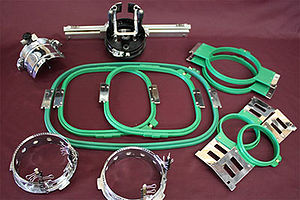Embroidery Machine Accessories
There are several different types of Embroidery Machine Accessories. The Embroidery Machine Accessories are used for embroidering different types of garments. For example, there are accessories for embroidering on caps and there are different accessories for embroidering jacket backs.
When embroidering on different materials, it might be necessary to change the needles. For more information see Embroidery Needles.
Types of Embroidery Machine Accessories
Hoops tubular, etc 270 caps, standard caps stands spider frames/hoops
Hoops and Hooping
Embroidery hoops are clamping devices used to hold the backing and fabric in place when using the embroidery machine. Modern hoops for machine embroidery are made of plastic. By placing the fabric in a hoop, the fabric stays in place and the hoop moves as controlled by the machine. Hooping the garment correctly is an important part of the embroidery process.
Selecting the Appropriate Hoop
Select the smallest hoop possible. Use the smallest hoop possible (that fits the design) in order to ensure that tension is even across the fabric. Make sure to leave at least a half-inch (1.27cm) on all sides of the design. This will enable good design registration.
Select the right shape. Most hoops are round or oval so this is not usually a problem. The rounded shape provides for more even tension on the fabric.
Use of hoop of the appropriate material. Most hoops are made of plastic so this is not a major concern. Some are made of wood and there are some cap frames and specialty hoops that are made of metal. Special hoops made of wood called Double-Height hoops are used to hold heavy or slippery fabrics.
Types of Hoops
Tubular. This type of hoop is used when the machine table is dropped. Tubular hoops snap into a tubular sash and allow the fabric to flow freely. This makes it easier to embroider on finished garments.
Flat. This type of hoop is used when the machine table is in the up position. There are special framing systems that allow you to load and unload these hoops with ease. Flat hoops are typically used for unfinished garments or fabric.
Cap Frames. This type of hoop is used to embroider on caps. They are typically curved metal hoops made to hold caps in place.
Care of Hoops
Hang up hoops when not in use. If they are left flat they can become warped or get chipped.
Hold the metal bar to insert hoops. When inserting the hoops into the machine do not push the wood or plastic - hold the metal bar or brackets.
Mark the hoop. This way you can always keep the top and bottom pieces together.
Guidelines for Hooping
Make sure the backing is large enough to fill the entire hoop. By hooping the entire piece of backing, you will better maintain even tension on the garment.
Smooth out the garment and backing. Do this before placing the hoop and make sure there are no folds or wrinkles in the garment once it is hooped.
Stretch the garment. Stretch the garment to how it will be worn before hooping it. If the garment stretches when it is worn, it will make the fabric around the embroidery look puckered.
Adjust the hoop before hooping. Do not tighten the screw after hooping the garment or it may cause "hoop burn" on the garment or cause the design to register poorly.
Marking the garment. Mark the garment with tailor's chalk, masking tape, straight pins or marking pens. This will help show you where the center of the design should start. If you are sewing many of the same garment you may be able to mark the first one, then use the hoop itself as a guideline for the remainder of the items to be embroidered.
Placement Guidelines
Left Chest. Center straight down from the shoulder seams 6-8" (15.2-20.3cm) and over 4-5" (10.1-12.7cm) Shirt Pockets. Center between the seams of the pocket down from the edge Jacket Backs. The center of the design should be about 6-9" (15.2-22.8cm) down from the collar
